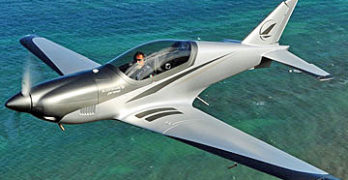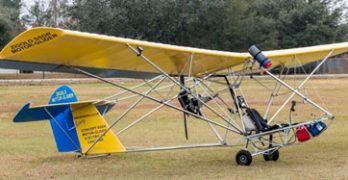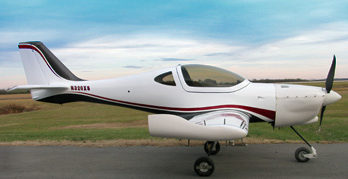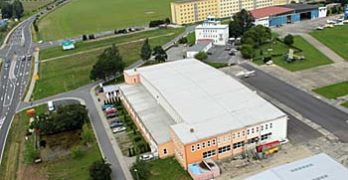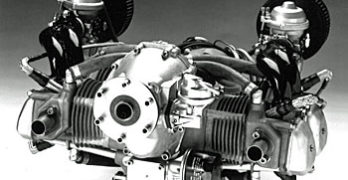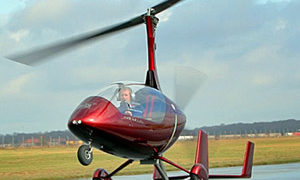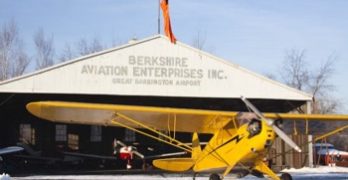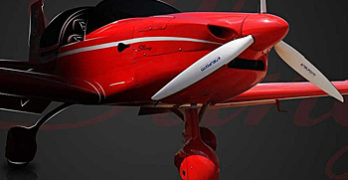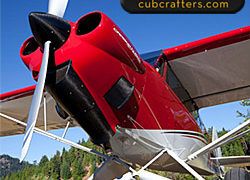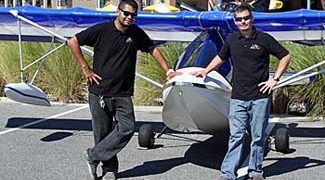At Aero 2013 in Friedrichshafen, Germany, I was caught by the smooth, lean lines of an airplane called Prime by designer/producer Blackshape. The LSA-sized two seater has an aggressive yet sweeping physique and small frontal area that benefits from tandem seating. While powered by Rotax and light enough to otherwise qualify as a Light-Sport, Prime has retractable gear and an in-flight adjustable prop so it cannot currently meet U.S. regulations. However, it has been approved by Transport Canada in their Advanced Ultralight Aircraft class that is very similar to LSA. Though speculation has continued for years, Canada has yet to embrace the U.S. LSA regulatory scheme. By the way, Aero 2014 is scheduled for April 9-12 — immediately following Sun ‘n Fun 2014 (April 1-6) — and ByDanJohnson.com reporters will be on the scene to catch the newest offerings from Europe
Blackshape’s Prime will be distributed in North America by the Aircit Aviation-Aviasport partnership.
Search Results for : MG 21
Not finding exactly what you expected? Try our advanced search option.
Select a manufacturer to go straight to all our content about that manufacturer.
Select an aircraft model to go straight to all our content about that model.
Flying the Zigolo Motorglider … a Pilot Report
For many of us, the principal reason we fly is for fun. Not to go anywhere but up, or for no other reason than that the sky is always waiting, but never impatient. Unfortunately this very pure idea became subverted along the way, as the Cubs and Champs of our forefathers were replaced by the efficient but banal 150 and PA28.
As the fun diminished the costs rose in proportion. One of the original ideas behind the whole LSA concept was affordability, but with some aircraft now priced up to $200,000 that particular principle seems to have been forgotten [though more modestly priced LSA do remain available]. Consequently, when Chip Erwin of Aeromarine LSA told me at the 2014 Sebring LSA Expo that he was bringing a new aircraft to market that required minimal assembly yet cost only $16,000 including the motor and a parachute rescue system you can bet I was interested.
Lightning XS Contrasts with FK131 Jungmann
In my previous post I made a passing mention of a coming flock of four seat aircraft loosely based on the two seat LSA that five manufacturers are presently building. As promised, more on that later. In this post I want to focus on two alternative directions. First is the Arion Aircraft Lightning XS, a kind of big brother to the Lightning LS, which can be flown as a SLSA, ELSA or EAB kit. You don’t need a medical to fly LS. You will for the XS (or “Excess”) and you will have to build it, but the newest variation from Arion promises to be a hot performer realizing the potential this all-American design has always possessed.
Arion boss Nick Otterback said, “We flew our new kit the Lightning XS [that] is based on our popular Jabiru powered Lightning kit but with several design changes incorporated.” XS has been designed to allow engines up to 160 horsepower.
Flight Design Expands to Accommodate Growth
Since the beginning of Light-Sport Aircraft almost ten years ago — this summer at EAA AirVenture, the SP/LSA sector will celebrate its tenth anniversary with special functions — Flight Design has continuously led the fleet size statistics as seen in our market share charts. In recent years, along with most other LSA manufacturers, a tough global economy slowed the enterprise. However, as 2013 began to show renewed sales activity and with positive forecasts for 2014 and 2015, Flight Design and many other of the LSA “majors” have been again growing their staff, inventory, and physical facilities. Recently the German company sent photos of its new quarters in Kamenz (pronounced like “commons”) in eastern Germany almost directly north of Prague in the Czech Republic.
Most senior staff moved from the company’s Stuttgart, Germany base to the new facility and the Light-Sport models including the CT series and more are now housed in a spacious hangar on an airport.
“Engine that Changed Aviation” — Rotax 912
The big company bills the now-iconic Rotax 9-series engines as “The Engine that Changed Light Aviation.” Today, few would dispute the claim that the 912 altered light aviation with its low weight and modern design, although Continental Motors, Lycoming, and others have long supplied powerplants for the light aircraft of earlier periods. On Valentine’s Day 2014, Rotax BRP celebrates the 25th Anniversary of its Rotax 912 engine. The four cylinder engine series that now dominates the light aircraft landscape got started in 1989 and was introduced to Americans a couple years later. The company started production of aircraft engines in 1973. Their first certified aircraft engine was delivered in 1975.
In answering the question about the potential for a new aircraft engine, Rotax BRP said it perceived, “… market demand … for a modern, reliable engine that would meet the expected performance. In 1985, the company started the development of a two-cylinder flat engine especially for the aircraft business.
The Other LSA Revolution (Except Not SLSA)
Wings that go around in circles enjoy their own special niche in American Light-Sport aviation. Yankees can buy ultralight helicopters — including the Mosquito that can fit into Part 103, which is amazing in itself — and Americans can buy kit-built gyrocopters or gyroplanes (the terms are used interchangeably). The good news is Americans do indeed buy and build; AutoGyro USA sold some 30 examples in the last couple years. However, due to an apparent (and somewhat mysterious) intraagency dispute, fully built Special LSA gyroplanes were never allowed by FAA. Some say it was a turf war between the Small Aircraft Directorate and the Rotorcraft Directorate; though others disagree this was the problem. Whatever the explanation, no ready-to-fly LSA gyros are available in the USA despite years of effort by ASTM committee members, which has a standard ready. This is a shame as I rediscovered for myself on a flight at Sebring.
The Year of Cub Love
In case you hadn’t heard, this is the Year of the Cub…the 75th anniversary celebration of that wonderful proto-LSA, the *** Piper J3 Cub. *** All aircraft have their special places in our hearts. But was there ever anything quite like the wonderful Cub? If you haven’t had the pleasure, take some dual just to see what our forebears learned to fly in. You’ll not only gain appreciation for how much better your stick-and-rudder skills could be, but it will, I’ll wager, also infuse your soul with a real bit of love for flying, true grassroots Americana style. There just isn’t anything quite like the sensation of lifting off behind a Continental four-banger of varying horsepower (the one I rent is a Continental with 65 ponies) and struggling at a leisurely pace for altitude. *** Wikipedia has a tasty lead-off to its abstract that I want to share with you: it cuts through the flowery verbosity to capture in unadorned prose the essence of what the Cub has meant to generations of pilots: *** The Piper J-3 Cub is a small, simple, light aircraft that was built between 1937 and 1947 by Piper Aircraft.
Slings from Down Under Airplane Factory
Welcome to summertime … in December, just after Christmas?!? True, down under in Australia or partway around the southern hemisphere in South Africa, weather patterns are roughly opposite of those in the northern half the globe. While it is presently cool or cold where many readers live, perhaps it is of interest to take a tour of a down-under manufacturer, in this case South Africa’s The Airplane Factory (TAF), designer and manufacturer of the Sling series of Light-Sport Aircraft, four seat models — some built ready to fly and some kits. In case you may have forgotten, the two seat Sling that now qualifies as a LSA was bravely flown around the world shortly after it was introduced by partners and frequent very long distance pilots Mike Blythe and James Pitman.
TAF’s American representative is The Airplane Factory USA. The California-based importer’s main main, Matt Litnaitzky, recently visited his supplier, snapping photos and giving us some additional insight to the organization behind the Sling series.
CubCrafters Upgrades Industry’s Best Seller
Top selling aircraft models in the LSA space over the last couple years are manufactured by CubCrafters. It’s not too strong to say they’ve done well because the Yakima, Washington company got the formula right: Start with an iconic design; add features the original Piper version never dreamed of having; pump it up with lots more power; add in a finer finish, modern materials, and instruments; upgrade it steadily; and finish by doing it all in the USA. To continue building on the best performance among any LSA producer, the company announced a range of updates for their Carbon Cub SS and Sport Cub S2 Light-Sport Aircraft for 2014.
Soon we’ll release the first market share stats of 2013 and through the first nine months of the year CubCrafters has a clear lead. Last year, Cessna registered more aircraft but the Wichita giant has been completely quiet in 2013 giving room for CubCrafters to soar.
Aero Adventure: Kit Seaplane Company’s New Factory
The city of Tavares, Florida ought to be feeling good about their effort to become their adopted name: America’s Seaplane City (FA1). The city built a fine facility and seaplanes are using it. Yet the strongest measure of their success may be that the city, located about 45 minutes northwest of Orlando, has attracted not one but two seaplane manufacturers. I’ve written about Progressive Aerodyne and their SeaRey several times. We’ve done video with Aero Adventure since Alex Rolinski took over the operation. Recently, we were hosted by Alex Gutierrez as we paid a visit to their new factory following a laborious move from Rockledge, Florida to Tavares.
In 2013, this a tale of two men named Alex and a familiar brand in the light kit arena. The longtime friends got together in central Florida after Alex R purchased the rights, designs, and inventory of Aero Adventure.
- « Previous Page
- 1
- …
- 57
- 58
- 59
- 60
- 61
- …
- 94
- Next Page »


